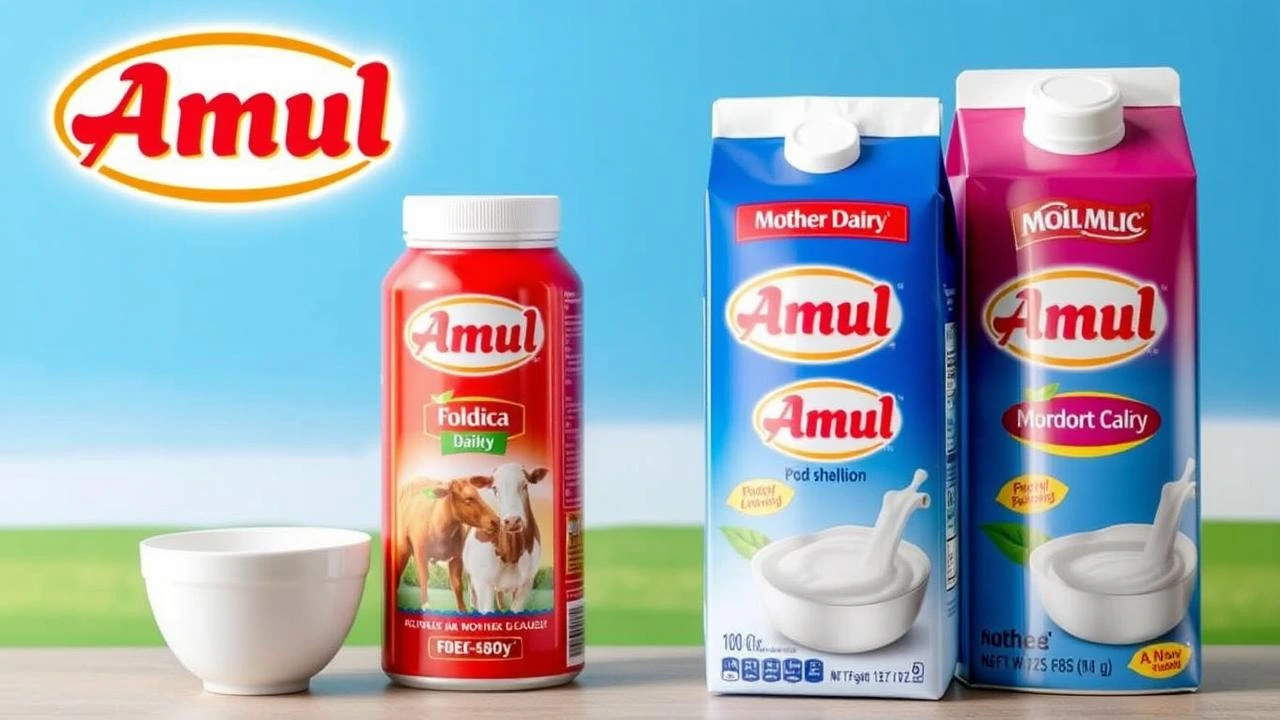In a testament to its enduring legacy and widespread consumer trust, Amul, the venerable Indian dairy cooperative, has once again secured the top spot in India’s food brand valuation, achieving an impressive valuation of $4.1 billion. This remarkable figure underscores Amul’s dominant position in the nation’s fast-moving consumer goods (FMCG) sector, particularly within the competitive dairy and food landscape. Following closely behind is Mother Dairy, another prominent player, indicating the significant market share held by these major dairy cooperatives.
The report, highlighting the evolving dynamics of India’s food industry, positions Amul not just as a producer of milk and dairy products, but as a powerhouse brand that resonates deeply with millions of Indian households. This consistent leadership is a result of decades of strategic growth, a commitment to quality, and an unparalleled distribution network that reaches even the most remote corners of the country.
Amul: A Legacy of Growth and Consumer Trust
Founded in 1946, Amul (Anand Milk Union Limited) has grown from a small cooperative in Gujarat to become a symbol of India’s white revolution. Its success is deeply rooted in the cooperative model, empowering millions of dairy farmers and ensuring fair prices while simultaneously delivering high-quality products to consumers. This farmer-centric approach, coupled with strong brand building and marketing, has been instrumental in Amul’s sustained growth and its ability to command such a high valuation.
The brand’s portfolio is remarkably diverse, encompassing everything from liquid milk, butter, and cheese to ice cream, chocolates, and even bakery products. This extensive range allows Amul to cater to a wide spectrum of consumer needs and preferences, further solidifying its presence in the daily lives of Indians. The iconic “Amul Girl” mascot, a cheerful and relatable figure, has been a constant companion in advertising campaigns, fostering a sense of familiarity and affection that few other brands can match.
“Amul has not just sold products; it has sold a dream of self-reliance and a better life for millions of our farmers. Its brand value is a reflection of that deep connection.”
The report’s findings are particularly significant in the context of India’s burgeoning economy and the increasing purchasing power of its consumers. As the middle class expands, so does the demand for branded food products, and Amul has consistently demonstrated its ability to meet and exceed these expectations.
Mother Dairy: A Strong Contender in the Dairy Landscape
Mother Dairy, a subsidiary of the National Dairy Development Board (NDDB), also holds a significant position in the Indian food market, securing the second spot in the brand valuation. Established in 1974, Mother Dairy has also played a pivotal role in the dairy sector, focusing on providing quality milk and milk products to urban consumers. Its commitment to hygiene, affordability, and accessibility has made it a trusted name across various cities.
Similar to Amul, Mother Dairy offers a comprehensive range of dairy products, including milk, curd, butter, ghee, and ice cream. It has also diversified into edible oils, fruits, and vegetables, broadening its market reach and consumer base. The brand’s emphasis on direct sourcing from farmers and its robust cold chain infrastructure are key enablers of its success.
Factors Driving Brand Valuation
Several key factors contribute to the high brand valuations of leading food companies like Amul and Mother Dairy:
- Consumer Loyalty and Trust: Decades of delivering consistent quality and value have fostered deep-seated loyalty among Indian consumers.
- Extensive Distribution Networks: The ability to reach a vast and diverse population, even in remote areas, is a critical advantage.
- Product Diversification: Offering a wide array of products catering to different tastes and needs allows brands to capture a larger market share.
- Effective Marketing and Branding: Iconic mascots, relatable advertising, and consistent brand messaging build strong emotional connections with consumers.
- Backward and Forward Integration: Control over the supply chain, from sourcing raw materials to final distribution, ensures quality and cost-efficiency.
- Adaptability to Market Trends: The ability to innovate and introduce new products in response to changing consumer preferences is crucial for sustained growth.
Amul’s Strategic Approach: A Closer Look
Amul’s consistent performance can be attributed to several strategic pillars:
- The Cooperative Model: This model ensures that the benefits of the enterprise are shared directly with the farmers, fostering commitment and a sense of ownership. This translates into a more stable and high-quality supply chain.
- “Taste of India” Positioning: Amul has successfully positioned itself as a taste that is synonymous with India, transcending regional boundaries.
- Innovation in Product Development: The brand continuously innovates, launching new products like probiotic yogurt, multigrain bread, and a variety of cheese products to cater to evolving health consciousness and lifestyle changes.
- Aggressive Marketing: Amul’s marketing campaigns are not only memorable but also often topical, addressing social issues or national events, thereby maintaining high brand recall.
- Cost Leadership: Through operational efficiencies and economies of scale, Amul is often able to offer its products at competitive prices, making them accessible to a broader consumer base.
The Competitive Landscape
While Amul and Mother Dairy lead the pack, the Indian food market is highly competitive, with numerous other players vying for consumer attention. Britannia Industries, ITC Foods, and Nestle India are some of the other prominent brands that contribute significantly to the nation’s food sector. The report’s findings, however, underscore the unique strength of the cooperative dairy model in establishing deep-rooted, high-value brands.
The sustained growth of these dairy giants also reflects the increasing health consciousness among Indian consumers, who are actively seeking nutritious and wholesome food options. Dairy products, being a rich source of protein and calcium, naturally benefit from this trend.
Future Outlook for India’s Food Brands
The future for India’s food brands looks exceptionally bright. With a young population, rising disposable incomes, and increasing urbanization, the demand for processed and packaged foods is expected to continue its upward trajectory. Amul, with its established brand equity and farmer-centric approach, is well-positioned to capitalize on these opportunities and further consolidate its leadership.
Mother Dairy, too, has significant potential for growth, especially in expanding its reach to Tier 2 and Tier 3 cities and diversifying its product offerings further. The ongoing focus on modern retail, e-commerce, and direct-to-consumer models will also play a crucial role in shaping the future landscape of food brand valuations.
Table 1: Top Indian Food Brands by Valuation (Illustrative)
| Rank | Brand | Valuation (USD Billion) | Key Product Categories |
|---|---|---|---|
| 1 | Amul | 4.1 | Milk, Butter, Cheese, Ice Cream, Chocolates, Yogurt |
| 2 | Mother Dairy | N/A (Significant) | Milk, Curd, Ice Cream, Edible Oils, Fruits & Vegetables |
| 3 | Britannia | N/A | Biscuits, Dairy Products, Bakery Products |
| 4 | ITC Foods | N/A | Packaged Foods, Snacks, Dairy Products, Biscuits |
| 5 | Nestle India | N/A | Confectionery, Dairy, Prepared Meals, Baby Food |
(Note: Valuations for brands other than Amul in this table are illustrative and based on general market presence and reports, not the specific report referenced for Amul’s valuation.)
Frequently Asked Questions (FAQs)
- What is brand valuation and why is it important? Brand valuation is the process of determining the financial worth of a brand. It’s important because it reflects a brand’s market position, consumer loyalty, and its potential for future revenue generation. It’s a key indicator of a company’s intangible assets.
- How does Amul maintain its top position in brand valuation? Amul maintains its position through a combination of consistent product quality, a strong cooperative model that benefits farmers, extensive distribution networks, effective marketing, and continuous product innovation.
- What is the significance of the cooperative model in Amul’s success? The cooperative model empowers millions of dairy farmers, ensuring fair prices and a steady supply of quality milk. This farmer-centric approach builds strong stakeholder relationships and contributes to the brand’s authenticity and trust.
- What are the primary factors contributing to the high valuation of food brands in India? Key factors include strong brand equity, consumer trust, extensive distribution, product diversification, effective marketing strategies, and the ability to adapt to changing consumer preferences and market trends.
- How is the Indian food market evolving? The Indian food market is evolving with increasing consumer demand for processed and packaged foods, a growing health consciousness, greater penetration of modern retail and e-commerce, and a rise in disposable incomes.
In conclusion, Amul’s continued dominance in India’s food brand valuation list is a powerful narrative of how a brand, built on trust, farmer empowerment, and a deep understanding of the Indian consumer, can achieve unparalleled success. As the market continues to grow and evolve, Amul’s established strength, coupled with the potential of other major players like Mother Dairy, promises an exciting future for the Indian food industry.
Amul tops India’s food brands list with $4.1 billion valuation, followed by Mother Dairy: Report






